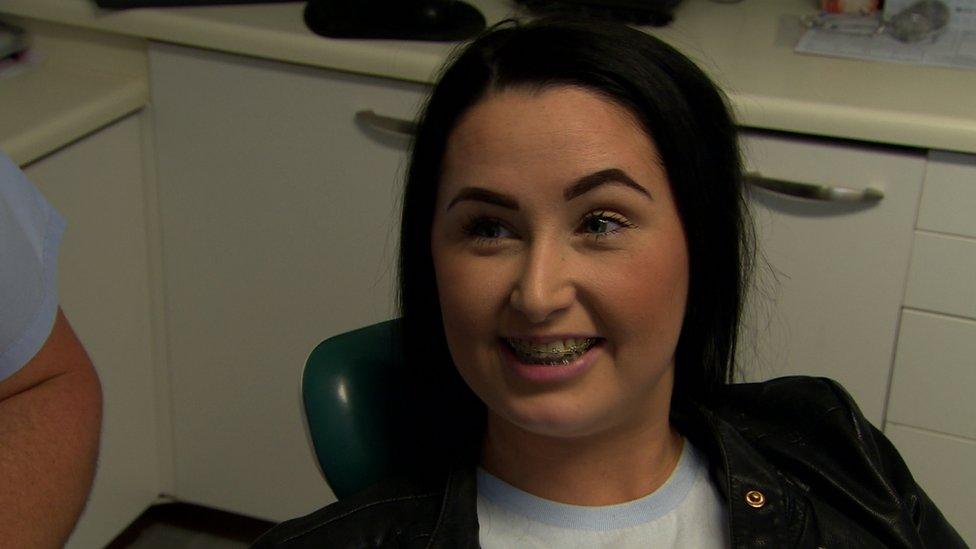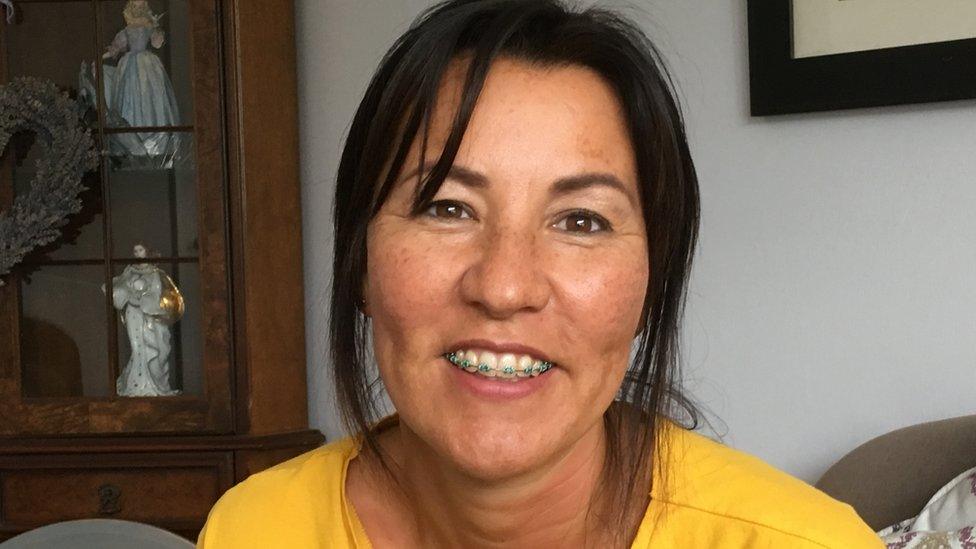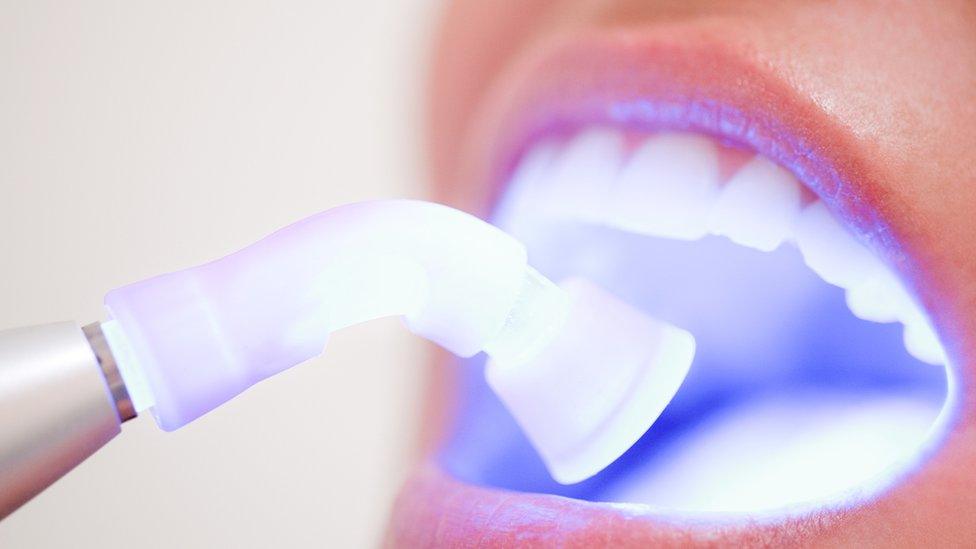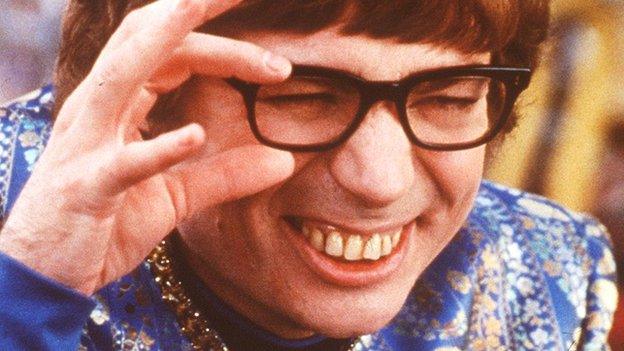Adult braces: More people paying thousands for straighter teeth
- Published
In pursuit of a nice smile
Orthodontists say there has been a large increase in the number of adults getting braces in a bid for straighter teeth.
Figures from the British Orthodontic Society (BOC) indicate that the number of adults seeking orthodontic treatment in the UK remains high.
Some 75% of orthodontists have reported an increase in adult private patients.
The treatment can often cost thousands of pounds and takes months or years to complete.
However, that is not putting people off.
The survey also shows that the majority of patients are in the 26 to 55 age bracket and most likely to be women, but the number of men seeking treatment is also on the rise.
Orthodontic treatment - usually with braces - is most often used to improve the appearance and alignment of crooked, protruding or crowded teeth.
Treatment usually occurs with children when their adult teeth have started to come through at about the age of 12.

Marc Slevin said social media may be playing a role in the search for a more perfect smile
Marc Slevin, a dentist who offers orthodontic treatment in Cookstown, County Tyrone, said he had noticed an increase in adults seeking braces over the past decade.
"Over the years we have noticed more adults are coming through the door enquiring about orthodontic treatment," he said.
"We are getting a lot of adults who are coming through the door for the second time round.
"They had braces when they were younger, maybe they did not look after their retainers or lost their retainers and now their teeth have moved back into a position that maybe they do not like them, and when they smile they are more aware of their teeth.
"The other type of adults, often in their 50s and 60s, are seeking treatment for the first time.
"Maybe social media is playing a big factor in it nowadays and they want to straighten their teeth and have a more perfect smile."
Shauna Anderson is 28 and has had braces fitted for the second time.
"I had braces when I was about 12 or 13 and I did not wear my retainer.

Shauna Anderson wanted treatment ahead of her sister's wedding
"I did not look after them when I was a child, so I sort of thought in my late 20s that I would go back and try to get a bit of confidence in my smile.
"I have a sister getting married and I suppose I wanted a wee bit more confidence in photographs and more confidence in myself.
"The first thing I see about somebody is their teeth so it is nice having nice teeth of your own to look at."
Ms Anderson, from County Tyrone, regrets not wearing her retainer when she got her braces off as a child, but said she would not make the same mistake again.
"As an adult I suppose you have to pay for them... so I will definitely look after them this time."

A brace consists of small brackets, which are bonded on to the teeth and moved by a thin wire
Donna Law, from Antrim, never had a brace when she was younger, but became more conscious of her teeth in the last few years.
"As time went on and seeing pictures it made me think I want to get them done," she said.

Donna Law said she cannot wait to have her braces removed
The 42-year-old and mother-of-two said she had loved the whole orthodontic process and never felt too old to get braces.
"I think it is definitely a little bit more acceptable," she said.
"I have seen loads of people that are a lot older than me with them that have spurred me on."
She said she could not wait to get her braces off, but said she had noticed a difference in how straight her teeth are now.
Adults are not normally eligible for NHS treatment, so they commonly have to pay for treatment, although this also offers a greater choice of types of braces.
Prices vary depending on the type of treatment.

The treatment
A brace consists of small metal brackets, which are bonded on to the teeth.
The brackets are moved using a thin wire held in place using tiny elastic bands, also known as ligatures.
Fixed braces are the most common type. They can be made from different materials, most commonly stainless steel but also gold or tooth coloured.
They are usually fitted to the outside of the teeth but a more recent development has seen braces that are fitted to the back of the teeth
Aligners are another type - they are clear, removable mouthguard-style braces that straighten the teeth gradually.
A brace is usually worn from nine to 18 months.

The cost of treatment did not put Ms Law off.
"I think when I first heard how much it cost I was kind of a bit put back, but then looking at pictures every time and seeing and noticing the difference in my teeth, I thought it was worth it if it is going to be long term," she said.
With an increase in adults returning for a second time for braces, why has their treatment worked first time around?
"You have moved the tooth through that bone," said Mr Slevin.
"If you do not wear the retainers, the bone is still quite soft, so the tooth will move back into the original position and move in quite quickly."
So what are the important things to remember after getting orthodontic treatment?
The orthodontist provides a removable retainer which patients should wear to stop their teeth reverting back to their pre-treatment positions.
"So it is important to look after your retainers once your orthodontic treatment is finished," he said.
- Published2 May 2019

- Published27 May 2015
